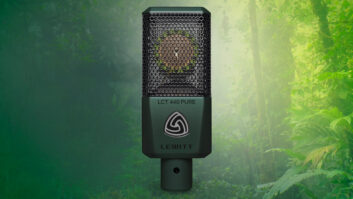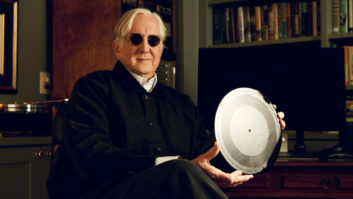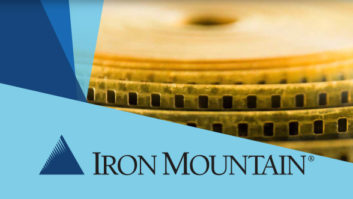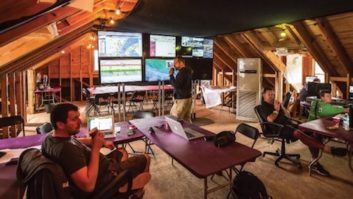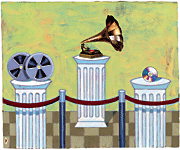
Illustration: Peter Bennett
Should you ever encounter the words “recording industry” and “legislation” in the same sentence, run away as fast as possible. For those of us trying to make an honest living in this business, most of the bills that have affected us in the past few decades have not been our friends. From the failed tax on blank tape in the early 1980s, the more successful Miscommunications Act of 1996, the Sony-Bono-and-all-his-Descendants-unto-the-Seventh-Generation-Term Extension Act and the Dismal Millennium Copyright Act (my names, not theirs), these bills have been designed to promote and protect the interests of the major corporate players in the entertainment world at the expense of just about everyone else.
But there are exceptions to every rule, even this one. In November 2000, a bill was quietly signed into law by former President Clinton called the National Sound Recording Preservation Act (NSRPA). This act stipulated that the Library of Congress establish the National Recording Registry, which would contain recordings that “are culturally, historically or aesthetically important, and/or inform or reflect life in the United States.” Beginning in 2002 and each year following, 50 recordings — out of scores of nominations — have been added to the registry. The idea for the Recording Registry follows on the success of the National Film Registry, which was established four years earlier and includes 25 new entries each year.
The sound recordings in the registry cover a tremendous amount of territory — from Edison cylinders to rap records, from ethnological field recordings to political speeches. The most recent list, for example, includes Sophie Tucker’s first recording on a 1911 cylinder; Woodrow Wilson’s Armistice Day broadcast of 1923, believed to be the earliest surviving electrical recording; Glenn Miller’s 1939 recording of “In the Mood”; the 1953 low-budget smash “Songs By Tom Lehrer”; a set of 1989 recordings of Asian elephants by Cornell University scientist Katharine B. Payne, which revealed that the animals use infrasonic sounds to communicate; Public Enemy’s Fear of a Black Planet; and Nirvana’s Nevermind. The only rules are that a nominated recording be at least 10 years old and that a copy of it actually exists.
A standing advisory committee — known as the National Recording Preservation Board — makes the selections and comprises members from some 17 organizations involved with music and sound recording, including NARAS, ASCAP, BMI, the RIAA, the Society for Ethnomusicology, the American Folklore Society and the Audio Engineering Society. Each organization names a committee member and an alternate, and there are five “at-large” members appointed by the Librarian of Congress, including such luminaries as Mickey Hart, Michael Feinstein and Phil Ramone.
While being included in the Registry would be an honor for any artist or producer, there’s more to the Library’s efforts than just singling out recordings of merit. The NSRPA also specifies that the Preservation Board study and report to the Librarian of Congress the current state of preservation techniques and practices, as well as how best to make archived materials available to researchers and educators. According to the two delegates to the board from the AES — George Massenburg and Elizabeth Cohen (the alternate) — this part of the mission is critical to the recording industry’s health, looking both backward and forward, and gives the AES an important role on the board.
“The AES was approached to recommend someone to the Librarian [of Congress] who had good experience in music and engineering,” says Massenburg, who, with his extensive track record in engineering, production, design and education, certainly fits that description, “and who would be able to help with discussions on any number of levels, working with preservationists and archivists. I loved the idea that we were going to cherry-pick recordings of great cultural significance. I learned about a lot of things that I’d missed. There are some brilliant people on the board with careers in music-immersive fields. Everyone cares deeply about music and preserving it. That’s the key.
“We’re tracing the roots, looking back at the great thread of musical styles, how one influenced another,” he continues. “Given that perspective, you see that only a small percentage of the artists in any given genre are really inspired — their work is transcendent and influential — while the others you view as ‘entertainers.’ The process gives us a chance to look at the really important innovators and how seminal their work was. Criticisms of the day fall away so you can see the work better in perspective. For instance, at the time he was composing, George Gershwin was thought of as being good with melodies, but he wasn’t much of a symphonist.
“Some of the early, flat acoustical discs are extraordinary work. I never knew about this before, but when electrical recording was introduced, people complained it was too cold and brittle and wanted the warmth and natural intimacy of acoustic recordings. Now what does that sound like?”
Cohen, a leading acoustical engineer with academic appointments at Stanford and UCLA, and a former AES president, helped write the original legislation. “The major contribution of the AES to the board, as regards to the registry, is to speak up for recordings that demonstrate important changes in technology,” she says. “We spoke up for Edison recordings and recordings that couldn’t have been made without new mic techniques.”
For example, there was a 1951 recording by Rafael Kubelik and the Chicago Symphony Orchestra of Mussorgsky’s called “Pictures at an Exhibition.” Massenburg explains, “It was a single-mic recording. They set up a [Neumann] 47 in the middle of the hall and rehearsed the orchestra really well. It was a major departure because before then, electrical recording had been all about close mics and technicians doing the balancing without much in the way of ambience. This was, ‘Let’s play music in a hall and record what it sounds like.’
“We wanted to include [The Beatles’] Sgt. Pepper’s Lonely Hearts Club Band as a turning point in modern recording: the use of technology to tell an interesting, focused story, [one that] also stood the test of time,” Massenburg continues. “We wanted to emphasize methodologies that were unique and innovative. Of course, Les Paul had to be in there — a guy who will stop at nothing to try an idea. But we’re not going to recommend a technology for its own sake. Nobody’s getting a listing for Best Plug-In.”
There are countless recordings that have been lost during the years, some of them legendary performances that were recorded and then misplaced. Part of the mission is to ensure that doesn’t happen again.
“We now have 100 years’ worth of recorded sound, and our job is to make sure that that legacy is accessible to future generations,” Cohen says. “It’s an act of cultural preservation: preserving that record of human creativity across time. But there are so many endangered recordings. We have an enormity of challenges: Obsolete formats are becoming harder for us to hear, hardware and the technical expertise to operate the hardware are becoming harder to obtain, the materials are deteriorating and people don’t know how to handle the materials to preserve them. You can’t imagine how much material has been lost due to bad labeling or boxes that corrode.
“Part of our work is to do a study on the state of audio preservation and develop a comprehensive national preservation program. We have to become intelligent advocates to management and show them why preservation is an important issue: how you store things and how to establish a data migration policy for a studio, especially in terms of metadata like session and track information. We’re working with recording companies and individuals, making sure that deliverables have migration advice with them.”
“A newborn digital project is a lot more difficult to keep track of than anyone imagined,” notes Massenburg, who has also worked on this issue at the behest of NARAS and the nonprofit Council on Library and Information Resources. “In the old days, there was a master tape. With analog multitrack — even with digital multitrack — there was almost always a master with a track sheet inside and some descriptive notes on the back. But with hard disk recordings, looking at your ‘master’ tells you little. There’s no established protocol to name things and no archive structure to handle it, much less preserve it. In time, certain new technologies become unreadable and evolving computer applications can’t read old project files. We’ve been told, in confidence, that some records have been lost. One thing we found at the major labels was that their libraries were incompatible; each of them was making it up as they went along. Many of us feel that it would be an asset to music preservation to just help libraries coordinate metadata.”
“We need to develop a series of best practices for how to move the bits from point A to point B before the media decays, or the hard drive or tape drive fail, or the software collapses,” Cohen advises. “Even today, if you have digital audio on Beta tapes or memory sticks, just try to read that! And we need hard disks that last a decade rather than just two years. Everything comes with error correction, but you have to know how to read it and use it. Amateurs can do this, too. We can educate individuals on how to handle their own collections. But there’s a four-letter word that people have to use: ‘plan.’
“There is a whole array of related technologies such as compression and lossless compression that other fields deal with, like data storage, medical imaging and supercomputing. We need to look at where things are going: nanotechnology, RAID arrays, grid computing, holographic storage — all of these are vital. I would like to see leadership coming from audio engineers in these fields so our applications are on the radar screen of the people developing them.”
Around the time you read this, the physical repository will be opening for the first time at the National Audio Visual Conservation Center in Culpeper, Va., some 70 miles from Washington, D.C. But the work is going slowly. “They’re already overtaxed, and they only get $250,000 a year in government money,” says Massenburg. “I don’t think they’re even halfway through the first year’s list. They wanted 25 items a year and we wanted 100, so we compromised on 50. There’s a radio station in New Orleans — WWOZ, jazz and heritage public radio — and we elected to list their entire archives. But that’s a huge job, and it’s just one item on the list. When we wanted to list the entire Edison collection, they declined.”
And, according to Cohen, a single physical location is not necessarily enough. “We’ve learned enough from floods and fires that we need to mirror these repositories,” she says. “Networks make that easy, but you need good practices and coordination between various archives.”
And there’s another issue, which is particularly tricky given the current state of copyright law. “The public today equates preservation with access,” says Cohen, “and there’s a public demand for preserved recordings. The idea of preservation is no longer museums with objects under glass that have restrictions around them. People want to be able to reach their own cultural heritage. It shouldn’t be so far away from them that they’re deprived of hearing those recordings.
“This requires greater access than is allowed by copyright restrictions. We need to determine how to handle orphaned recordings and how to deal with copyright issues over unidentifiable or unreachable sources. Sometimes there’s no known originator for recordings, but they’re locked up because someone may have an economic interest in them. There’s a huge amount of material that could be released if we could deal with these legal issues. We’re working to find a balance between the need for broader access and respecting international property rights. The intent of a lot of works was to be heard and performed, and locking it up in a way that makes it inaccessible to an audience is disrespectful.”
As for getting your favorite recordings into the National Registry, there are ways to do that. “There’s no limit to public nominations,” says Massenburg. “Anyone can bring a nomination to Elizabeth or myself. Public nominations have a decided edge in consideration. On the other hand, you can imagine how many times people nominate a Beach Boys record. We had a preservation session at the 2003 AES in New York and passed out a form. Now you can do it online at the Library of Congress’ site. The procedure changes every year, but if something doesn’t make it one year, we can roll it over and nominate it the next year.”
“There’s great expertise in the board,” says Cohen, “but there’s greater expertise in the public at large. The public can be advocates for things that the board may not be aware of. If you make good arguments, then you might be persuasive. We’d love to see an increase in nominations from the AES membership and Mix readers. As long as it had a cultural, historical or aesthetic impact on the U.S., it can be nominated. It doesn’t have to have been made in the U.S.”
“We don’t know what will be important in 50 years,” says Massenburg. “Some obscure record might turn out to be very influential. We need everybody’s support and participation to help us uncover that work.”
The National Recording Registry’s site is www.loc.gov/rr/record/nrpb/nrpb-nrr.html. Feel free to, as Cohen says, “Vote early and vote often.”
Paul Lehrman has several thousand LPs, all of which (he hopes) are in pretty good shape.
